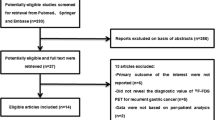Abstract
Purpose
In order to assess the diagnostic performance of Positron emission tomography/Computed tomography (PET/CT) for detecting recurrence in gastric cancer patients with clinical or radiologic suspicion of recurrence after surgical resection.
Materials and methods
Over a 4-year period, 105 post-operative patients with gastric cancer, who underwent PET/CT due to clinical or radiologic suspicion of recurrence during follow-up, were collected after confirming their PET/CT findings. The number and site of positive FDG uptake were retrospectively analyzed, and were correlated with the final diagnosis, by calculating the diagnostic values and assessing the causes of misdiagnosis.
Results
Of all 105 patients, 75 patients were confirmed to have true recurrence with 108 recurrence sites. The sensitivity, specificity, positive predictive value, negative predictive value and accuracy for diagnosing true recurrence on a per-person basis were 75%, 77%, 89%, 55%, and 75%, respectively. On a per-lesion basis, 75 (69%) of 108 true recurrences showed positive FDG uptake, while 75 (89%) of 84 positive FDG uptake was confirmed to have true recurrence.
Conclusion
PET/CT was relatively accurate in detecting recurrence in post-operative patients with gastric cancer. Moreover, PET/CT might be helpful in confirming the presence of recurrence particularly in patients who were highly suspicious of recurrence, because of its high positive predictability.



Similar content being viewed by others
References
Schwarz RE, Zagala-Nevarez K (2002) Recurrence patterns after radical gastrectomy for gastric cancer: prognostic factors and implications for postoperative adjuvant therapy. Ann Surg Oncol 9:394–400
Yoo CH, Noh SH, Shin DW et al (2000) Recurrence following curative resection for gastric carcinoma. Br J Surg 87:236–242
Kodera Y, Ito S, Yamamura Y et al (2003) Follow-up surveillance for recurrence after curative gastric cancer surgery lacks survival benefits. Ann Surg Oncol 10:898–902
Kim KW, Choi BI, Han JK et al (2002) Postoperative anatomic and pathologic findings at CT following gastrectomy. Radiographics 22:323–336
Ha HK, Kim HH, Kim HS et al (1993) Local recurrence after surgery for gastric carcinoma: CT findings. AJR Am J Roentgenol 161:975–977
Mullin D, Shirkhoda A (1985) Computed tomography after gastrectomy in primary gastric carcinoma. J Comput Assist Tomogr 9:30–33
Kinkel K, Ly Y, Both M et al (2002) Detection of hepatic metastasis from cancers of the gastrointestinal tract by using noninvasive imaging methods (US, CT, MR imaging, PET): a meta-analysis. Radiology 2002:748–756
Yoon YC, Lee KS, Shim YM et al (2003) Metastasis to regional lymph nodes in patients with esophageal squamous cell carcinoma: CT versus FDG PET for presurgical detection-prospective study. Radiology 227:764–770
Flamen P, Lerut A, Van Cutsem E et al (2000) The utility of positron emission tomography (PET) for the diagnosis and staging of recurrent esophageal cancer. J Thorac Cardiovasc Surg 120:1085–1092
Flamen P, Stroobants S, Van Cutsem E et al (1999) Additional value of whole-body positron emission tomography with fluorine-18–2-fluoro-2-deoxy-D-glucose in recurrent colorectal cancer. J Clin Oncol 17:894–901
Yeung HW, Macapinlac H, Karpeh M et al (1998) Accuracy of FDG-PET in gastric cancer. Clin Positron Imaging 1:213–221
Stahl A, Ott K, Weber WA et al (2001) Correlation of FDG uptake in gastric carcinomas with endoscopic and histopathological findings. J Nucl Med 42:78–79
Yun M, Lim JS, Noh SH et al (2005) Lymph node staging of gastric cancer using 18F-FDG PET: a comparison with CT. J Nucl Med 46:1582–1588
Mochiki E, Kuwano H, Katoh H et al (2004) Evaluation of 18F-2-deoxy-2-fluoro-D-glucose positron emission tomography for gastric cancer. World J Surg 24:247–253
Kim S-K, Kang KW, Lee JS et al (2006) Assessment of lymph node metastases using 18F-FDG PET in patients with advanced gastric cancer. Eur J Nucl Med Mol Imaging 33:148–155
De Potter T, Flamen P, van Cutsem E et al (2002) Whole-body PET with FDG for the diagnosis of recurrent gastric cancer. Eur J Nucl Med Mol Imaging 29:525–529
Jadvar H, Tatlidil R, Garcia AA et al (2003) Evaluation of recurrent gastric malignancy with [F-18]-FDG positron emission tomography. Clin Radiol 58:215–221
Lardinois D, Weder W, Hany TF et al (2003) Staging of non-small-cell lung cancer. N Engl J Med 348:2500–2507
Antoch G, Saoudi N, Kuehl H et al (2004) Accuracy of whole-body dual-modality fluorine-18–2-fluoro-2-deoxy-D-glucose positron emission tomography and computed tomography (FDG-PET/CT) for tumor staging in solid tumors: comparison with CT and PET. J Clin Oncol 22:4357–4368
Keidar Z, Haim N, Guralnik L et al (2004) PET/CT using 18F-FDG in suspected lung cancer recurrence: diagnostic value and impact on patient management. J Nucl Med 45:1640–1646
Kamel IR, Cohade C, Neyman E et al (2004) Incremental value of CT in PET/CT of patients with colorectal carcinoma. Abdom Imaging 29:663–668
Reinartz P, Wieres F-J, Schneider W et al (2004) Side-by-side reading of PET and CT scans in oncology: which patients might profit from integrated PET/CT? Eur J Nucl Med Mol Imaging 31:1456–1461
Kostakoglu L, Hardoff R, Mirtcheva R et al (2004) PET-CT fusion imaging in differentiating physiologic from pathologic FDG uptake. Radiographics 24:1411–1431
Blake MA, Singh A, Setty BN et al (2006) Pearls and pitfalls in interpretation of abdominal and pelvic PET-CT. Radiographics 26:1335–1353
Lim JS, Yun MJ, Kim M-J et al (2006) CT and PET in stomach cancer: preoperative staging and monitoring of response to therapy. Radiographics 26:143–156
Author information
Authors and Affiliations
Corresponding author
Rights and permissions
About this article
Cite this article
Park, M.J., Lee, W.J., Lim, H.K. et al. Detecting recurrence of gastric cancer: the value of FDG PET/CT. Abdom Imaging 34, 441–447 (2009). https://doi.org/10.1007/s00261-008-9424-4
Published:
Issue Date:
DOI: https://doi.org/10.1007/s00261-008-9424-4




